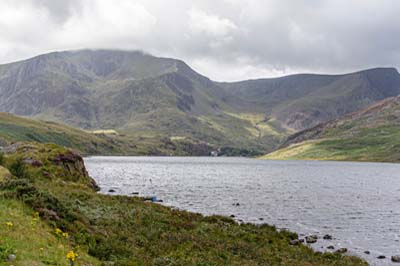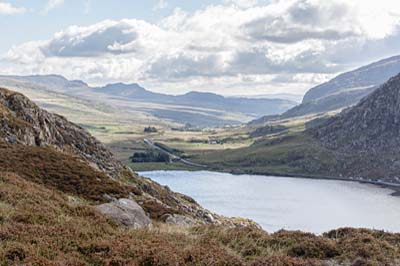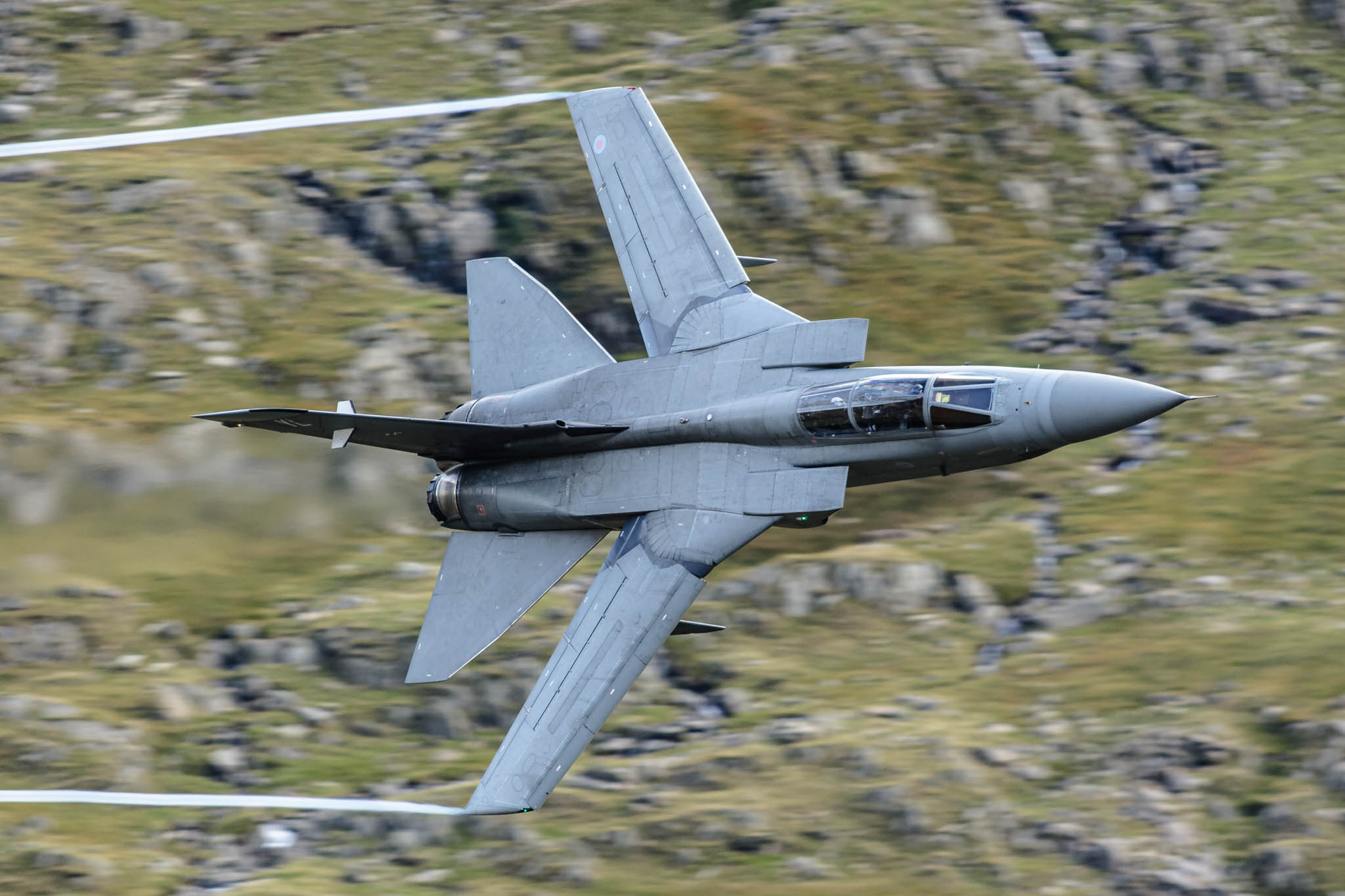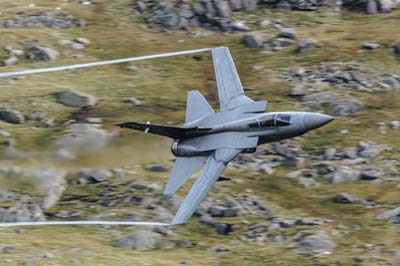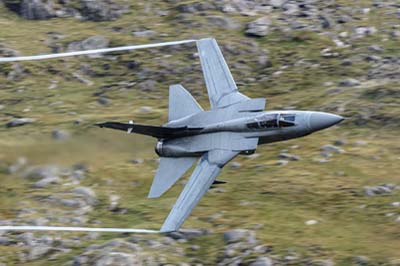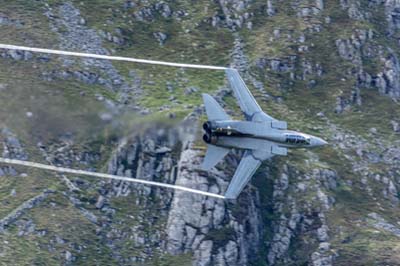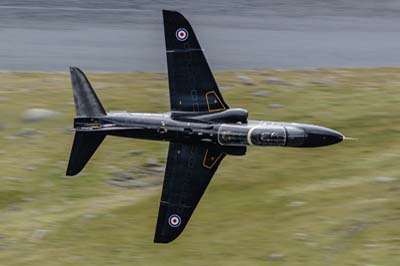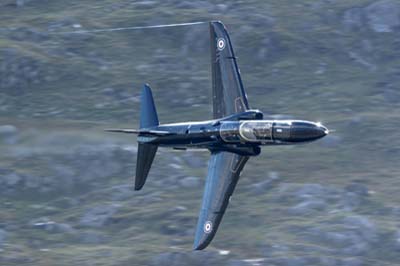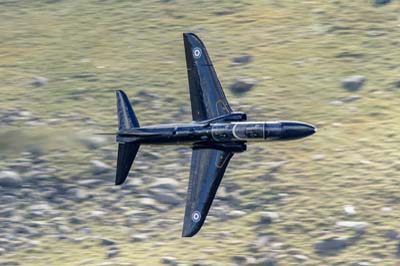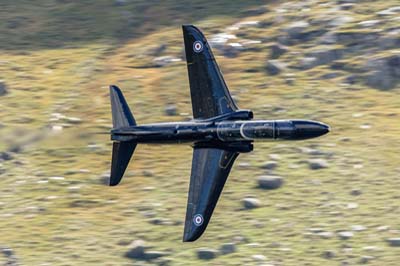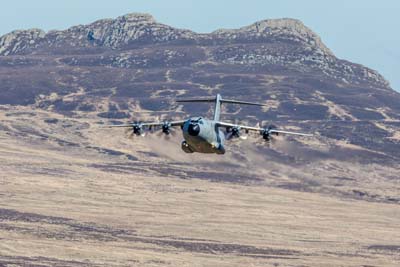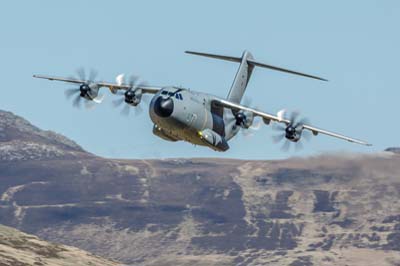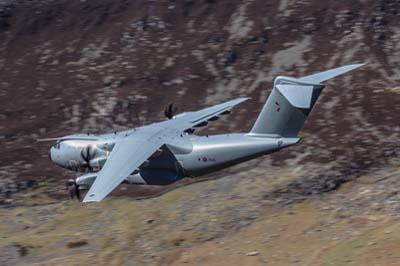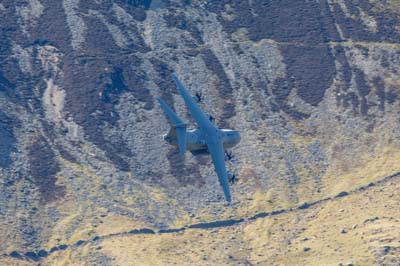Low-level Photography
A5 Pass at Ogwen, Snowdonia, Wales
|
The A5 pass through the Ogwen Valley forms part the main low-level route used by pilots inbound to RAF Valley on Angelsey, Wales. It is very popular with instructors due to its challenging right hand turn at the end of the valley. Following are two pilot's accounts of one of their flights through the valley long after they have passed pilot training at RAF Valley.
Paul Courtnage 'Courtney' - A pilot's view of the A5 Pass.
Paul Courtney a former fighter pilot with the RAF has written his memoirs 'Vox Clamantis in Deserto' - Cortney's Journal, it can be read in full here
With his permission I have copied an extract describing his extraordinary ride in a German Navy Lockheed TF-104G Starfighter through the A5 pass when he was with 29 Squadron (1980-1983) flying the FGR.2 Phantom at RAF Coningsby.
"... we had an exchange with 2MFG1, a German Navy outfit who were flying the ageing Starfighter, the legendary F-104, also known as the 'widow maker' due to the number of pilots (especially German ones) it had killed. They were a pleasant bunch and, in time honoured fashion, we enjoyed some good flying against them and an enthusiastic social life. In fact, there were times when we were all as enthusiastic as newts. On this occasion, I was a member of the 'home team' hosting the Germans at RAF Coningsby. Their Squadron Boss had decided to bring with them a couple of their 2-stick F-104s, in the back of which he wanted we Brits to fly. It was during a particularly enthusiastic social gathering that the subject of a back seat ride cropped up in conversation and he invited me to go along and fly with him the following day. Well, it seemed like a good idea at the time.
For the rest of the evening, we discussed all the places we could go and, as he was particularly interested in low-flying, I was able to recommend some excellent valleys and mountain ranges through which we could fly. The most exciting one that sprang to mind was the A5 pass, which runs on the northern side of Snowdon and which is especially stimulating because of its depth, sheer sides and a particularly challenging 90° bend. I had been round the pass many times in a Hawk and even once in the F4, although, with its larger turning circle, that had been a bit of a tight squeeze. Warning!
The following morning, I was handed a helmet that was at least three sizes too big, a set of 'g' pants that would have fitted a Sumo wrestler and a torso harness that almost, but not quite, fitted my frame. Well, not to worry; as I said, I was indestructible. We climbed in and blasted off across the Lincolnshire countryside in our 'aluminum (sic) death tube'. When he first gave me control of the jet, I thought there must be something wrong with it. It would roll just fine, but pull on the stick and the nose would move, but the jet's direction didn't appear to change. It was very fast, very stable, but wouldn't turn for passion nor Lord Lucan's life assurance pay out. I realised that this aircraft was not built for going round corners, least of all the one in the middle of the A5 pass. Sensibly, I endeavoured to talk 'Fritz' out of attempting to take this hurtling piece of machinery around such a tight bend, especially as, once committed to it, there would be no safe escape route. 'No, no, it vill be all right, Courtney', he reassured me unreassuringly. He didn't realise how tight or enclosed this valley was. Further attempts to dissuade him from our chosen course were ineffective. Now I'm not one to panic easily, as you know and I'm not given to jumping to conclusions, but I was getting the distinct impression that all was not well or, rather, all was not going to be well.
As we headed west, Snowdonia, shrouded in heavy, black, oily clouds, hoved into view. 'Oh, bugger,' I proclaimed, feigning disappointment. 'It's much too cloudy so we won't be able to go that way.' Unfortunately, the mantle of cloud merely hid from him the extent and topography of the underlying hard centre. Granite, millions of years old and hard as, well, granite, really. There was a letterbox shaped gap under the cloud tall enough, but only just, to fit an F-104 through. We were low and fast. In fact it was the sort of lowness and fastness that I would describe as 'bloody low' and 'bloody fast'. As we approached the corner, being mindful of the jet's less than average turn performance, I advised him to roll right and start pulling. When I say 'advised' I mean I advised him very loudly. 'No, no, ve are not at ze corner yet', he replied, still blissfully ignorant of the tight 90° bend that was rushing towards us. Then he realised. There was cloud above and rock on all sides. We both played briefly with the idea of pulling up, but the cloud hid the mountains above and we couldn't be sure whether there was room.
He rolled the aircraft violently 120° right and started to pull. Through the top of the canopy, all I could see was rock. Close. As we approached the edge where the valley drops away, I saw 20 or so mountain climbers with open mouths and wide eyes flash past my head. The aircraft shuddered under the force of the air trying vainly to alter our flight path as he hauled on the stick. It really didn't look like we were going to make it. Not even close. I thought of ejecting, but knew that there was no where to go. Over my head was solid granite and, besides, none of the kit I was wearing fitted properly. If the ejection wearing that stuff didn't kill me, slamming into a Welsh mountainside at the best part of 500 miles per hour surely would. The last thing I saw out of the top of the 104s canopy was the bottom of the valley, still skating past sideways as we approached the far valley wall, belly-up to it. It looked very much like we were going to slam into the wall of rock. Rock 1 : Starfighter 0.
For the only time in my life, I was absolutely certain that I was about to die. Surprisingly, I wasn't at all scared, nothing went into slow motion and the only thing that flashed before my eyes was the valley floor. Then, just as I knew it was coming, I realised that we were just about going to make it. As we rolled out of the turn, I could almost have reached out and touched the rock face, blurring past the left side of the jet. There was no conversation in the aircraft for a long while. We decided to look for somewhere straighter to fly and had a very pleasant and far less exciting time doing it. I have never met anyone else who has taken a 104 round the A5 pass and I now know why. I did it a year or so later in an F4 Phantom and that was tight, but nothing like doing it in the F-104."
Paul Courtnage
|
Michael Rondot - A pilot's view of the A5 Pass.
Michael Rondot is a very accomplished military aviation artist, his paintings and prints can be viewed and purchased from the Collectair Limited Editions website.
During his 25 years of service in the RAF many of his 5,000 hours were in fast-jets at low-level. The text that follows was written by Michael Rondot and describes vividly his first experience of the A5 Pass.
"My first encounter with the A5 pass at Ogwen came in 1969 when I was a student pilot flying the Folland Gnat trainer from RAF Valley. My instructor, a chap called Norrie Bell, took control of the aircraft at the end of a training sortie and said "Shut up and watch, I want to show you something." We descended through a break in the cloud cover very low-level, closer to the ground than I had ever been except when landing and accelerated to 420 knots. This was my first experience of low-flying in the Gnat and I sat mesmerised in the front cockpit with eyes like saucers as the ground rushed past. Trees, water, stone walls and roads flashed by as we continued to accelerate to 480 knots. Suddenly we were in a deep u-shaped valley with a cloud-covered rock wall at the far end and, as far as I could see, no means of escape except by climbing and climbing very , very soon, like NOW! Next thing, I saw the ground rotate and we were in a hard 5G turn pulling DOWN into the valley floor with about 135 degrees of right bank and descending below the level of the road which I could see above my head. We raced out of the valley, still in the weeds until reaching Bethesda village when with a long sigh he handed over control to me and announced: "That, young Michael, was the A5 pass." I never forgot that experience and during the next 23 years I took every opportunity to revisit the A5 pass in whatever aircraft I happened to be flying. In 1977 I flew it in a Canberra PR9 on a windy day in poor weather but would not care to repeat the frightening experience.
I flew it many times in Hawk and Jaguar aircraft. For me it has a mystique unlike any other place in the UK low-flying system. The best students at RAF Valley got the chance to fly the A5 pass in formation just like these two in my painting ('Rock and Roll'), but I dare say the instructors in the back seats are doing the flying."
Michael Rondot
|
Inspired by Michael Rondot's words, which he wrote for his painting entitled 'Rock and Roll', I felt compelled to give the A5 pass a go. Up until this day in September 2006, I had overlooked this valley for low-level photography, in the mistaken belief that I would only see 4 FTS Hawks returning to their base at RAF Valley. Yes the pass is very busy with Hawks, but as you can see below front-liners also use this valley, even if Valley is not included in their flight plan.
So how was my first day at the A5 pass, perched on a rocky outcrop and facing the sun, on the corner of the pass? Thrilling is the first word that comes to mind. The day was shared with Gareth Jones a good friend and experienced low-level photographer, who has tried out the pass on a number of occasions. We imagined what a Canberra would have looked like in those nostalgic days of the 70s. He promised me Hawks, but really both of us were hoping for an elusive Tornado, trailing vortices, as it manoeuvred through the tight pass at the end of the valley. As another fellow low-level photographer says, 'never go, never know', so we stood in hope
waiting for the few seconds of pure excitement that a front-liner brings, when it appears a few miles east down the valley.
Will I go again, the answer is yes of course? The day has to be right, as you are looking into the sun I feel the ideal weather is damp and overcast but bright. We both agreed that in the winter months, it should be avoided as the sun would be very low and the climb is treacherous in places when it is wet.
Oh, I nearly forgot, many thanks to Michael Rondot for the inspiration and his permission for me to use his stunning words.
|

